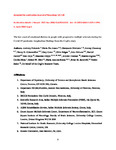The late onset of emotional distress in people with progressive multiple sclerosis during the Covid-19 pandemic: longitudinal findings from the CogEx study
| dc.contributor.author | Feinstein, A | |
| dc.contributor.author | Amato, MP | |
| dc.contributor.author | Brichetto, G | |
| dc.contributor.author | Chataway, J | |
| dc.contributor.author | Chiaravalloti, ND | |
| dc.contributor.author | Cutter, G | |
| dc.contributor.author | Dalgas, U | |
| dc.contributor.author | DeLuca, J | |
| dc.contributor.author | Farrell, R | |
| dc.contributor.author | Feys, P | |
| dc.contributor.author | Filippi, M | |
| dc.contributor.author | Freeman, Jennifer | |
| dc.contributor.author | Inglese, M | |
| dc.contributor.author | Meza, C | |
| dc.contributor.author | Motl, RW | |
| dc.contributor.author | Rocca, MA | |
| dc.contributor.author | Sandroff, BM | |
| dc.contributor.author | Salter, A | |
| dc.date.accessioned | 2022-11-16T15:16:33Z | |
| dc.date.issued | 2022-12 | |
| dc.identifier.issn | 0340-5354 | |
| dc.identifier.issn | 1432-1459 | |
| dc.identifier.uri | http://hdl.handle.net/10026.1/19980 | |
| dc.description.abstract |
Objective: An earlier follow-up study from the CogEx rehabilitation trial showed little change in symptoms of depression, anxiety and psychological distress during the first COVID-19 lockdown compared to pre-pandemic measurements. Here we provide a second follow-up set of behavioral data on the CogEx sample. Methods: This was an ancillary, longitudinal follow-up study in CogEx, a randomized controlled trial of exercise and cognitive rehabilitation in people with progressive MS involving 11 centres in North America and Europe. Only individuals impaired on the Symbol Digit Modalities Test (SDMT) were included. Participants repeated the COVID Impact survey administered approximately a year later and completed self-report measures of depression, anxiety and MS symptoms that had been obtained at the trial baseline and during the first COVID Impact survey. Participants who completed the second COVID Impact follow up were included. To identify predictors of the participants’ ratings of their mental and physical wellbeing, step-wise linear regression was conducted. Results: Of the 131 participants who completed the first COVID impact survey, 74 participants completed the second follow-up survey (mean age 52 (SD=6.4) years, 62.2% female, mean disease duration 16.4 (SD=9.0) years, median EDSS 6.0). Pandemic restrictions prevented data collection from sites in Denmark and England (n=57). The average time between measurements was 11.4 (SD=5.56) months. There were no significant differences in age, sex, EDSS, disease course and duration between those who participated in the current follow-up study (n=74) and the group that could not (n=57). One participant had COVID in the time between assessments. Participants now took a more negative view of their mental/psychological wellbeing (p=.0001), physical wellbeing (p=.0009) and disease course (p=.005) compared to their last assessment. Depression scores increased on the HADS-depression scale (p = .01) and now exceeded the clinically significant threshold of ≥ 8.0 for the first time. Anxiety scores on the HADS remained unchanged. Poorer mental wellbeing was predicted by HADS depression scores (p=.012) and a secondary-progressive disease course (p=.0004). Conclusions: A longer follow-up period revealed the later onset of clinically significant depressive symptoms on the HADS and a decline in self-perceptions of mental and physical wellbeing associated with the COVID-19 pandemic relative to the first follow-up data point. | |
| dc.format.extent | 6202-6210 | |
| dc.format.medium | Print-Electronic | |
| dc.language | en | |
| dc.language.iso | eng | |
| dc.publisher | Springer Science and Business Media LLC | |
| dc.subject | COVID-19 | |
| dc.subject | Progressive multiple sclerosis | |
| dc.subject | Mental well-being | |
| dc.subject | Longitudinal | |
| dc.subject | Depression | |
| dc.subject | Anxiety | |
| dc.title | The late onset of emotional distress in people with progressive multiple sclerosis during the Covid-19 pandemic: longitudinal findings from the CogEx study | |
| dc.type | journal-article | |
| dc.type | Randomized Controlled Trial | |
| dc.type | Journal Article | |
| plymouth.author-url | https://www.webofscience.com/api/gateway?GWVersion=2&SrcApp=PARTNER_APP&SrcAuth=LinksAMR&KeyUT=WOS:000837549900001&DestLinkType=FullRecord&DestApp=ALL_WOS&UsrCustomerID=11bb513d99f797142bcfeffcc58ea008 | |
| plymouth.issue | 12 | |
| plymouth.volume | 269 | |
| plymouth.publication-status | Published | |
| plymouth.journal | Journal of Neurology | |
| dc.identifier.doi | 10.1007/s00415-022-11295-5 | |
| plymouth.organisational-group | /Plymouth | |
| plymouth.organisational-group | /Plymouth/Faculty of Health | |
| plymouth.organisational-group | /Plymouth/Faculty of Health/School of Health Professions | |
| plymouth.organisational-group | /Plymouth/REF 2021 Researchers by UoA | |
| plymouth.organisational-group | /Plymouth/REF 2021 Researchers by UoA/UoA03 Allied Health Professions, Dentistry, Nursing and Pharmacy | |
| plymouth.organisational-group | /Plymouth/Research Groups | |
| plymouth.organisational-group | /Plymouth/Research Groups/Institute of Health and Community | |
| plymouth.organisational-group | /Plymouth/Research Groups/Plymouth Institute of Health and Care Research (PIHR) | |
| plymouth.organisational-group | /Plymouth/Users by role | |
| plymouth.organisational-group | /Plymouth/Users by role/Academics | |
| plymouth.organisational-group | /Plymouth/Users by role/Researchers in ResearchFish submission | |
| dc.publisher.place | Germany | |
| dcterms.dateAccepted | 2022-07-13 | |
| dc.rights.embargodate | 2023-8-8 | |
| dc.identifier.eissn | 1432-1459 | |
| dc.rights.embargoperiod | Not known | |
| rioxxterms.versionofrecord | 10.1007/s00415-022-11295-5 | |
| rioxxterms.licenseref.uri | http://www.rioxx.net/licenses/all-rights-reserved | |
| rioxxterms.licenseref.startdate | 2022-12 | |
| rioxxterms.type | Journal Article/Review |


